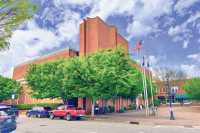Dillsboro dam is simply worth preserving
By Anna Fariello • Guest Columnist
OK, so I have to admit that part of the appeal of the Dillsboro/Duke battle appeals to me in the same way that David and Goliath inspired me as a child. Small-town-takes-on-giant-corporation has the makings of movie. While I am into confession, I should admit that I don’t quite get the science arguments, although I am sure there is soundness on both sides of the issue. But overall, it is my practical nature that wonders — if Duke doesn’t want this dam, why can’t Dillsboro have it? The entire battle seems ludicrous as I imagine corporate fat cats strategizing on how to take such a little dam down, plotting where to strategically plant sticks of dynamite.
When I taught in Central America almost 10 years ago, I was struck by how historically significant archeological sites lived side-by-side with spontaneous soccer matches. In this country we protect our national treasures with guided tours and admission fees. Did those ball-kicking children realize that they were in the holy presence of history? There I was sent to teach collections care and soccer was, indeed, not in the preservationist’s handbook.
As the semester progressed and I became more familiar with those sites, my initial shock gave way to an appreciation of what is commonly called “patrimonio” in Latin America. We have a comparable word in English — patrimony — but in cultures where personal property rights reign, the word does not carry the same weight of meaning. Indeed, my Webster’s definition is particularly lacking, defining patrimony as “property inherited from one’s father.” A more professional definition, and one shared by Latin America and other countries, might better define it as “property of the people,” or I should say “property of The People.”
The Dillsboro dam has been around for the better part of a century. It has only been the property of Duke Power since 1988. In the hearts and minds of many Jackson County citizens, the dam is part of their cultural landscape as sure as Cowee Mountain and the Tuckesegee. It is a sweet and picturesque spot, a place to pause and drink in the view.
Most people are familiar with the National Register of Historic Places, the federal program that designates historic buildings and sites as significant to our country’s heritage. Indeed, Dillsboro recently received such designation for the historic Monteith House, bestowing both honor to the town and making the property eligible for tax rehabilitation credits. State law also provides for lesser-known designations, those called historic landmarks and historic districts, which are more local in nature. These designations do not require the same stringent nomination process, nor do they bestow the same benefits as the National Register, but they do enable local governments and citizens to take advantage of a number of credible preservation tools.
Related Items
Historic landmarks and historic districts are administered by the N. C. Office of Archives and History and governed by specific North Carolina law. Local landmarks are designations that are applied to buildings or structures that have historical, architectural, archeological, or cultural value. While designation is honor, it is also a mechanism to assist with preservation planning and cultural conservation.
The process is not particularly difficult, but state law is specific and the process must adhere to defined procedures. The first step is that the locality — county or a joint commission of county and town managers — must establish an historic preservation commission or historic landmarks commission. This is the body that investigates and designates historic landmarks or districts for the locality that it serves. The commission is created by an ordinance adopted by the local governing board. After a commission is established, the local governing board appoints its members and provides enough support for it to operate. It is the commission that has the authority to designate local landmarks and districts with the state providing guidance and recommendations.
A local historic landmark does not have to be a building. The state allows for sites and structures to be included in the process. Yes, dams are specifically named as a category of “structure.” Once a landmark or district is recommended, the state reviews the designation and makes recommendations. A public hearing must be held. Once process is complete, it is the county attorney who drafts an ordinance to declare a local landmark. Interestingly, the consent of the property owner is not required.
I have pondered the plight of Dillsboro, a town that has had to endure the abandonment of the train, one of its fondest attractions. I have read and re-read explanations of sedimentation and mitigation with a limited understanding. I’ve been proud of the steadfast determination of our local leaders (some would say stubbornness, I am sure) to keep up their fight. Some have proposed making the dam operational and, who knows, the new administration may very well provide federal incentives for this as part of President O’Bama’s efforts to create “green” jobs. The idea of the Dillsboro Dam given designation as a historic landmark is not so far-fetched as it may sound. Surprisingly, Duke Power studied the possibility for itself in 2003. The “Eligibility Study of Seven Hydroelectric Projects in the Nantahala Area, North Carolina” is on the web.
Thinking back to Panama Viejo — “Old Panama,” the archeological site mentioned at the start of this essay — I recall the crumbling stone tower that was threatened with collapse. The National Institute of Culture had mounted a campaign for its salvation, adopting the motto, “Salve Tu Tore” (Save Your Tower).
I still have the mug, given to me by students at the end of the course, with the motto that seemed to be everywhere I looked. In class, we had agreed on the importance of delivering a succinct message that would resonate with anyone regardless of their level of interest or understanding of larger interpretive issues. “Salve Tu Tore” was printed on banners in the street, on the sides of city buses, in large newspaper ads, on tote bags, and coffee mugs. While the professional in me would advise careful planning and deliberate forward motion, the little girl awestruck by the audacity of David is ready to start printing T-shirts.
(Anna Fariello is Director of the Craft Revival and From the Hands of our Elders, projects of Western Carolina University’s Hunter Library. She can be reached This email address is being protected from spambots. You need JavaScript enabled to view it..)









